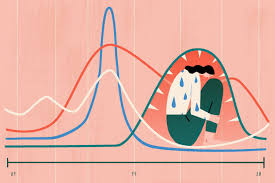Premenstrual Dysphoric Disorder

So, ladies, you know how every month one sudden day we start feeling extremely emotional or overwhelmed or infuriated or elated? And then we start to wonder what is wrong, not for long though, because we realize we are about to get our period.
These emotional rollercoasters, or the other physical and physiological changes we go through before we get our periods are what we commonly term “PMS” or Premenstrual Syndrome.
But did you know about PMDD?
Premenstrual dysphoric disorder is a severe, sometimes disabling extension of premenstrual syndrome. PMDD is usually self-diagnosable. It can cause extreme mood swings, feelings of hopelessness, irritability, anger, and sadness along with common physical symptoms such as bloating and breast tenderness.
Premenstrual Dysphoric Disorder can cause headaches, dizziness, heightened sensitivity of arms and legs, anxiety, and panic attacks.
What makes PMDD different from PMS is that PMDD can affect a person a lot more than PMS can. PMDD can cause severe appetite loss, insomnia or increased sleep, anxiety or panic attacks, and depressive episodes, and some people with PMDD become suicidal. It affects nearly 10 million women per year in India. Symptoms of PMDD include pain in the breast, muscles, and pelvic area, mood swings, anxiety or panic attacks, decreased interest in activities that you usually love, bloating, self-critical thoughts, lack of concentration, food cravings, and/or weight gain.
The exact cause of PMDD is still not fully understood but it is said that PMDD is caused by extreme sensitivity to hormonal changes that occur during a monthly menstrual cycle. Self-diagnosis can be done to see if PMDD affects you. If it does, you can start self-treatment by exercising regularly, improving your lifestyle and diet, managing stress, and avoiding alcohol and other substances. You can start practicing Yoga and meditation as well. Activity and nutrition are said to be the key components for managing PMDD symptoms. If you lead a sedentary lifestyle (as most of us do), you should include aerobic exercises in your daily routine, such as walking, jogging, running, and pilates. You can play a particular sport that you like, or dance for cardio exercise. For medications, you can consult a doctor and in case of need of therapy, you can visit a therapist.
-Sara Pimprikar is an 18-year-old physiotherapy student, classical dancer, mental health ally, Mind Matters columnist, and member of District Action Group on Mental Health Initiatives.








